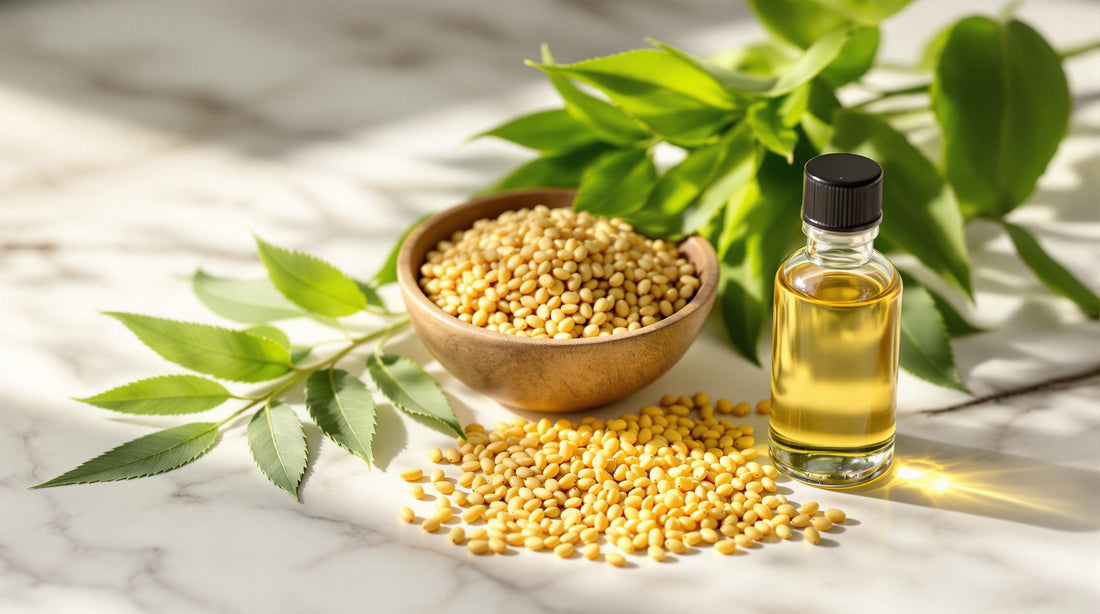
Best Natural Ingredients for Dandruff Control
Dandruff can be managed naturally using ingredients that soothe the scalp, reduce flaking, and improve overall scalp health. Here’s a quick summary of the most effective remedies:
- Neem: Fights dandruff-causing fungi (Malassezia) with antifungal properties. Use as oil, paste, or shampoo additive.
- Fenugreek: Moisturizes the scalp and balances pH. Apply as a paste made from soaked seeds.
- Aloe Vera: Soothes irritation and prevents dryness. Apply fresh gel or mix with tea tree oil.
- Tea Tree Oil: Antifungal and fights microorganisms. Always dilute with a carrier oil.
- Amla: Strengthens the scalp and reduces dandruff. Use as oil or a powder-based scalp mask.
Why Choose Natural Remedies?
- Gentle on Skin: Low risk of irritation compared to chemical products.
- Eco-Friendly: Biodegradable and planet-friendly.
- Long-Term Benefits: Promotes lasting scalp health.
For best results, combine these remedies with a consistent scalp care routine, a balanced diet, and stress management practices.
Home Treatments for Dandruff Using NEEM
Effective Natural Ingredients for Dandruff
Drawing from Ayurvedic principles that emphasize balancing Pitta and Vata, these five natural ingredients offer effective ways to manage dandruff:
Neem
Neem, often called "sarva roga nivarini" in Ayurveda (meaning "cure for all ailments"), is well-known for its antifungal and antibacterial properties. These qualities make it a powerful tool against dandruff, especially in targeting the Malassezia yeast, a common cause of flaking and itching [3][5]. Ayurveda emphasizes addressing the root cause, and neem fits perfectly into this approach [2][4].
| Method | Instructions |
|---|---|
| Oil Massage | Massage warm neem oil onto your scalp and leave it overnight. |
| Leaf Paste | Apply a paste made from neem leaves for 30 minutes, then rinse. |
| Shampoo Additive | Add 5-7 drops of neem oil to your shampoo during each wash. |
Fenugreek
Fenugreek seeds are another excellent option for dandruff control. Packed with lecithin, they moisturize the scalp while combating flaking. These seeds also contain natural acids that help balance scalp pH, further reducing dandruff [2].
To use fenugreek, soak the seeds overnight, grind them into a paste, and apply it to your scalp for 30 minutes. Rinse with a mild shampoo for the best results [6].
Aloe Vera
Aloe vera is known for its soothing and anti-inflammatory properties, making it ideal for calming irritated scalps. It also helps retain moisture, preventing dryness - a common trigger for dandruff [3][7].
How to Use Aloe Vera:
- Apply fresh aloe vera gel directly to your scalp.
- Mix it with a few drops of tea tree oil for added benefits.
- Use it as a pre-shampoo treatment for about 20 minutes.
Tea Tree Oil
Tea tree oil is a strong antifungal agent that has been shown to fight the microorganisms responsible for dandruff [3]. However, it should be used carefully to avoid irritation.
Usage Tips:
- Always dilute it with a carrier oil in a 1:10 ratio.
- Perform a patch test before full application.
- Add 5-7 drops to your shampoo for regular use.
Amla
Indian gooseberry, or amla, is packed with nutrients that strengthen the scalp and improve its natural defenses against dandruff [2]. It combines the wisdom of ancient remedies with the needs of modern scalp care.
Ways to Use Amla:
- Massage your scalp with amla oil regularly.
- Apply a scalp mask made from amla powder.
- Mix it with coconut oil for an overnight treatment.
Building a Natural Dandruff Control Routine
An effective dandruff control routine, inspired by Ayurvedic principles, combines consistent daily care, weekly treatments, and mindful lifestyle choices. These steps work best when followed in a structured plan.
Daily Scalp Care
Kickstart your day with a soothing 5-10 minute scalp massage using warm coconut oil mixed with 2-3 drops of tea tree oil. Follow this up with a gentle cleanse using a sulfate-free shampoo.
| Time of Day | Care Activity | Duration |
|---|---|---|
| Morning | Warm oil massage | 5-10 minutes |
| During shower | Gentle scalp cleansing | 2-3 minutes |
| Night | Dry scalp brushing | 1-2 minutes |
Weekly Treatments
Once a week, treat your scalp with Bhringraj oil for 30 minutes before washing. Alternatively, apply a cooling herbal mask made from neem, amla, and sandalwood mixed with coconut milk.
"Bhringraj oil is a powerful hair treatment that deters premature greying, dandruff, and scalp irritation." [5]
Diet and Lifestyle Tips
To complement your topical treatments, focus on nutrient-rich foods that support scalp health:
| Nutrient | Food Sources | Benefits |
|---|---|---|
| Zinc | Pumpkin seeds, lentils | Helps reduce scalp inflammation |
| Omega-3s | Flaxseeds, walnuts | Keeps the scalp moisturized |
| B Vitamins | Leafy greens, whole grains | Aids in scalp renewal |
Stress can worsen dandruff, so managing it is crucial. Incorporate yoga and meditation into your routine to help reduce stress-related scalp issues [2][8].
sbb-itb-5c7cdb5
Natural vs. Commercial Dandruff Products
Ayurvedic daily care practices highlight the importance of understanding the differences between natural and commercial dandruff treatments. Natural remedies focus on restoring scalp balance and addressing Pitta/Vata imbalances. On the other hand, commercial products often rely on synthetic ingredients to deliver fast results.
Comparison Table
| Aspect | Natural Ingredients | Commercial Products |
|---|---|---|
| Active Components | Neem, Tea Tree Oil, Aloe Vera, Fenugreek | Zinc Pyrithione, Selenium Sulfide, Ketoconazole |
| Effectiveness Timeline | Gradual improvement over 2-3 weeks | Fast relief within 1-2 washes |
| Side Effects | Minimal; gentle on scalp | Possible irritation, dryness, dependency |
| Long-term Benefits | Supports ongoing scalp health | May require continuous use |
| Cost Effectiveness | Generally more affordable | Higher cost for branded options |
| Environmental Impact | Eco-friendly, biodegradable | May include harmful chemicals |
| Application Method | Requires preparation and routine use | Convenient and ready to use |
| Shelf Life | Shorter; best when fresh | Extended due to preservatives |
Tea tree oil, for example, has been shown in clinical studies to have antifungal properties comparable to those found in commercial treatments [3]. While commercial products often deliver fast relief, they can lead to side effects like dryness or sensitivity over time [1].
For natural remedies to work effectively, proper application and consistency are key. Though results may take longer, they help establish long-term scalp health and reduce reliance on quick fixes [1][3].
Maximizing Natural Remedies' Benefits
Application Techniques
To get the most out of natural ingredients, applying them correctly is key. For strong oils like tea tree oil, always dilute them with carrier oils like coconut or jojoba oil to avoid irritation. A good ratio is 5-10 drops of tea tree oil mixed with 2 tablespoons of carrier oil before applying it to your scalp [3]. If you're using aloe vera, opt for fresh gel directly from the leaf or a trusted brand with pure gel to ensure effectiveness [7].
When working with herbal powders such as neem or fenugreek, mix them with water or oil until they form a smooth paste. Apply the mixture evenly to your scalp using gentle, circular motions. This not only ensures full coverage but also helps boost blood flow [5].
Consistency and Time
Natural remedies take time and regular use to deliver results. To keep treatments effective:
- Stick to a consistent application schedule.
- Follow recommended times, typically leaving treatments on for 30-60 minutes.
Combining Ingredients
Pairing natural ingredients can amplify their benefits. Here are some effective combinations:
| Primary Ingredient | Complementary Ingredient | Benefits |
|---|---|---|
| Tea Tree Oil | Aloe Vera | Combines antimicrobial effects with soothing properties |
| Neem | Fenugreek | Targets fungi while nourishing the scalp |
| Amla | Coconut Oil | Strengthens the scalp and balances oil levels |
For the best results, always use freshly prepared mixtures. For instance, you can blend fenugreek paste (made from soaked seeds) with neem oil to address both dandruff symptoms and underlying causes.
Conclusion: Achieving a Flake-Free Scalp
Natural ingredients provide a powerful way to manage dandruff while being gentle on your scalp. For example, tea tree oil, with its terpinen-4-ol component, has proven antimicrobial properties that target scalp fungi and bacteria effectively [3]. Pairing these natural remedies with the routine discussed earlier can help you build a solid plan to tackle dandruff.
Here’s what an effective natural treatment involves:
- Active Treatment: Applying natural ingredients like neem oil overnight for targeted care [6].
- Consistent Care: Maintaining a regular scalp care routine with proper techniques.
- Internal Balance: Supporting scalp health by improving diet and lifestyle habits.
Ayurvedic practices can also play a key role in addressing both the symptoms and root causes of dandruff [4]. As highlighted in our product comparison, natural treatments avoid the dependency risks associated with many commercial solutions while encouraging healthier hair and a better scalp condition over time.
Stick to the routine outlined in the Building a Natural Dandruff Control Routine section, and you’ll notice steady, lasting improvements. With dedication, achieving a healthy, flake-free scalp is well within reach.
FAQs
What is the Ayurvedic remedy for dandruff?
Ayurveda suggests balancing Pitta and Vata energies to address dandruff issues [8]. Common remedies include using neem-based treatments, applying cooling herbal masks like Thalapothichil, and trying detoxifying oil therapies such as Shiro basti [2].
How can I permanently get rid of dandruff naturally?
A natural approach involves three key steps:
- Use daily scalp treatments like tea tree oil shampoo (rich in antimicrobial terpinen-4-ol) and neem-based products [3].
- Adjust your lifestyle by improving sleep patterns and protecting your scalp from excessive sun exposure.
- Incorporate fiber-rich foods, steamed greens, and fresh fruits into your diet [2][8].
